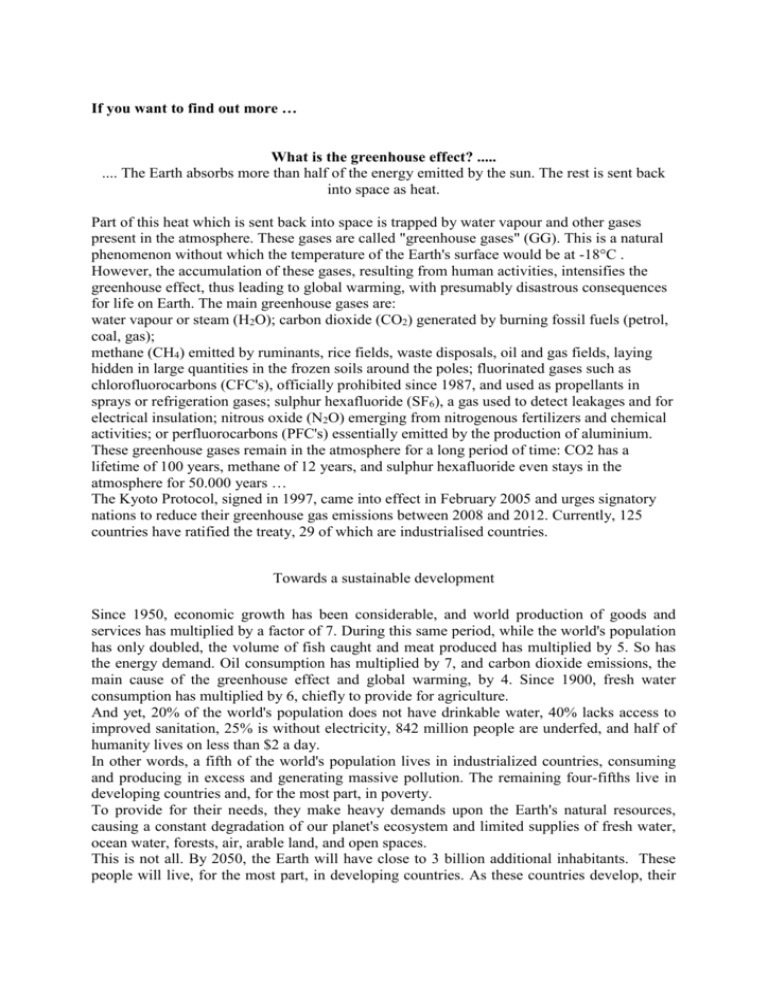To find out more
advertisement

If you want to find out more … What is the greenhouse effect? ..... .... The Earth absorbs more than half of the energy emitted by the sun. The rest is sent back into space as heat. Part of this heat which is sent back into space is trapped by water vapour and other gases present in the atmosphere. These gases are called "greenhouse gases" (GG). This is a natural phenomenon without which the temperature of the Earth's surface would be at -18°C . However, the accumulation of these gases, resulting from human activities, intensifies the greenhouse effect, thus leading to global warming, with presumably disastrous consequences for life on Earth. The main greenhouse gases are: water vapour or steam (H2O); carbon dioxide (CO2) generated by burning fossil fuels (petrol, coal, gas); methane (CH4) emitted by ruminants, rice fields, waste disposals, oil and gas fields, laying hidden in large quantities in the frozen soils around the poles; fluorinated gases such as chlorofluorocarbons (CFC's), officially prohibited since 1987, and used as propellants in sprays or refrigeration gases; sulphur hexafluoride (SF6), a gas used to detect leakages and for electrical insulation; nitrous oxide (N2O) emerging from nitrogenous fertilizers and chemical activities; or perfluorocarbons (PFC's) essentially emitted by the production of aluminium. These greenhouse gases remain in the atmosphere for a long period of time: CO2 has a lifetime of 100 years, methane of 12 years, and sulphur hexafluoride even stays in the atmosphere for 50.000 years … The Kyoto Protocol, signed in 1997, came into effect in February 2005 and urges signatory nations to reduce their greenhouse gas emissions between 2008 and 2012. Currently, 125 countries have ratified the treaty, 29 of which are industrialised countries. Towards a sustainable development Since 1950, economic growth has been considerable, and world production of goods and services has multiplied by a factor of 7. During this same period, while the world's population has only doubled, the volume of fish caught and meat produced has multiplied by 5. So has the energy demand. Oil consumption has multiplied by 7, and carbon dioxide emissions, the main cause of the greenhouse effect and global warming, by 4. Since 1900, fresh water consumption has multiplied by 6, chiefly to provide for agriculture. And yet, 20% of the world's population does not have drinkable water, 40% lacks access to improved sanitation, 25% is without electricity, 842 million people are underfed, and half of humanity lives on less than $2 a day. In other words, a fifth of the world's population lives in industrialized countries, consuming and producing in excess and generating massive pollution. The remaining four-fifths live in developing countries and, for the most part, in poverty. To provide for their needs, they make heavy demands upon the Earth's natural resources, causing a constant degradation of our planet's ecosystem and limited supplies of fresh water, ocean water, forests, air, arable land, and open spaces. This is not all. By 2050, the Earth will have close to 3 billion additional inhabitants. These people will live, for the most part, in developing countries. As these countries develop, their economic growth will jockey for position besides industrialized nations – within the limits of ecosystem Earth, which are not extensible. If everyone on earth lived the same lifestyle as people in the Western world, we would need at least two extra planets to sustain ourselves. But there is a way of improving the standard of living of all while at the same time preserving natural resources for the generations to come : we need to switch to non-polluting technologies that require less water and energy. The term « sustainable development » describes this goal : it means getting more from less. The Earth's situation is not an irreversible fatality, but changes do need to be undertaken as soon as possible. We have the opportunity to turn toward a sustainable development, one that allows us to improve the living conditions of the world's citizens and to satisfy the needs of generations to come. This development would be based on an economic growth respectful both of man and the natural resources of our unique planet. Such development requires improving production methods and changing our consumption habits. With the active participation of all the world's citizens, each and every person can contribute to the future of the Earth and mankind, starting right now. Anne Jankeliowitch for GoodPlanet.org









